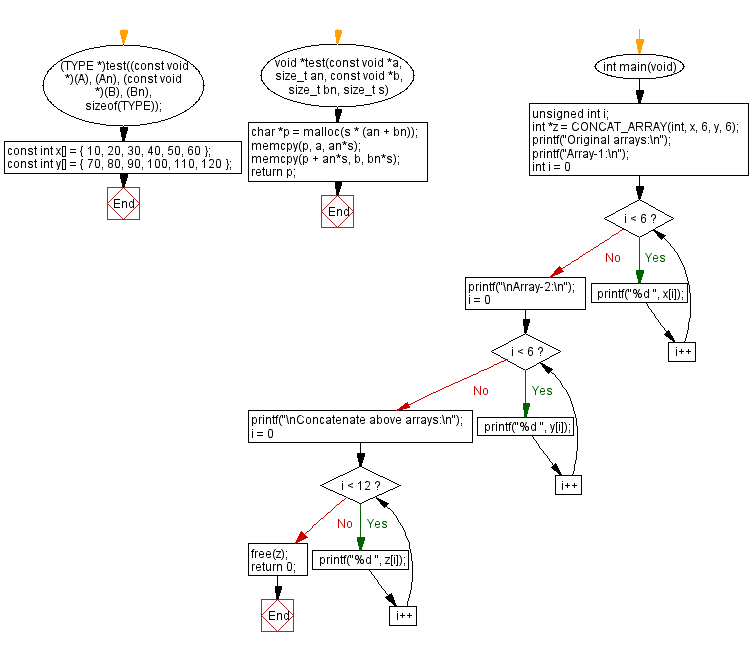C Exercises: Concatenate two arrays
107. Concatenate Two Arrays
Write a program in C to concatenate two given arrays of integers.
If this is as simple as array1 + array2, so be it.
Sample Data:
({ 10, 20, 30, 40, 50, 60 }, { 70, 80, 90, 100, 110, 120 }) -> "10 20 30 40 50 60 70 80 90 100 110 120"
Sample Solution:
C Code:
#include <stdlib.h>
#include <stdio.h>
#include <string.h>
// Macro to concatenate arrays of any type
#define CONCAT_ARRAY(TYPE, A, An, B, Bn) \
(TYPE *)concatenateArrays((const void *)(A), (An), (const void *)(B), (Bn), sizeof(TYPE));
// Function to concatenate arrays
void *concatenateArrays(const void *a, size_t an,
const void *b, size_t bn, size_t s)
{
// Allocate memory for the concatenated array
char *p = malloc(s * (an + bn));
// Copy elements from first array to concatenated array
memcpy(p, a, an * s);
// Copy elements from second array to concatenated array after the first array's elements
memcpy(p + an * s, b, bn * s);
// Return pointer to the concatenated array
return p;
}
// Sample arrays
const int x[] = { 10, 20, 30, 40, 50, 60 };
const int y[] = { 70, 80, 90, 100, 110, 120 };
int main(void)
{
unsigned int i;
// Concatenate arrays x and y
int *z = CONCAT_ARRAY(int, x, 6, y, 6);
// Display original arrays
printf("Original arrays:\n");
printf("Array-1:\n");
for(int i = 0; i < 6; i++)
printf("%d ", x[i]);
printf("\nArray-2:\n");
for(i = 0; i < 6; i++)
printf("%d ", y[i]);
// Display concatenated array
printf("\nConcatenate above arrays:\n");
for(i = 0; i < 12; i++)
printf("%d ", z[i]);
free(z); // Free dynamically allocated memory for concatenated array
return 0;
}
Output:
Original arrays: Array-1: 10 20 30 40 50 60 Array-2: 70 80 90 100 110 120 Concatenate above arrays: 10 20 30 40 50 60 70 80 90 100 110 120
Flowchart:

For more Practice: Solve these Related Problems:
- Write a C program to concatenate two arrays of integers using dynamic memory allocation.
- Write a C program to merge two arrays and then sort the resulting concatenated array.
- Write a C program to concatenate two arrays without using extra space by pre-allocating sufficient memory.
- Write a C program to concatenate two arrays and then remove any duplicate elements from the merged array.
Go to:
PREV : Array Transformation: Double Value & Zero Shift.
NEXT : C Programming Structure Exercises Home
C Programming Code Editor:
Have another way to solve this solution? Contribute your code (and comments) through Disqus.
What is the difficulty level of this exercise?
Test your Programming skills with w3resource's quiz.
